Here is a quick photo I snapped this evening of the Moon & Venus above our Skyshed. Sadly, it’s the most observing I’ve done in weeks! Here’s hoping that 2009 brings many clear skies!!
Happy New Year!!
Ann T.
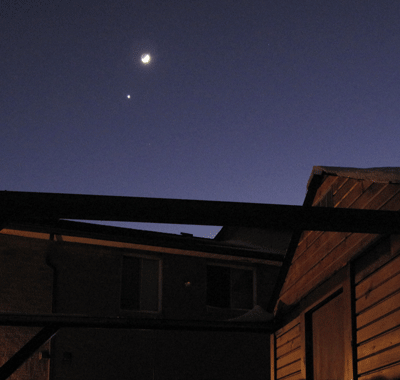
Here is a quick photo I snapped this evening of the Moon & Venus above our Skyshed. Sadly, it’s the most observing I’ve done in weeks! Here’s hoping that 2009 brings many clear skies!!
Happy New Year!!
Ann T.

Just a reminder that as the year draws to a close there is a beautiful conjunction forming in the western sky.
Just after sunset we see Venus high in the southwest, shining through the last light of the day. Tonight (December 29th) a very slim crescent moon is low in the west and if you have a good horizon you can look for Jupiter and Mercury below and to the right of the moon. Use binoculars to scan through the glow of sunset, but make sure the sun is well down below the horizon before you start. Tomorrow (December 30th) the Moon will move up to the bottom right of Venus as it approaches the planet. Finally, on December 31st the Moon and Venus meet to make a beautiful pairing and Jupiter and Mercury also meet to complete this double conjunction night.
So if the weather is clear keep an eye on the sky starting now and bring in the new year with a look at this lovely sky.
Update: 31 Dec 2008 13:50 by Don Pullen
The CSC is indicating some clear skies tonight. If you find yourself at a dark location trying to observe the conjunctions, you may stick around for full darkness after the moon sets around 9pm. According to SpaceWeather.com, we are entering a solar wind stream which may provide some auroras visible from our latitude.
After the Friday night meeting and dinner, I mustered up the energy to catch some frames of the Horsehead nebula with a Baader 7nm Hydrogen Alpha filter. This type of narrowband imaging certainly opens up doors for astrophotography under light polluted skies.
I had a few challenges but it was great to finally catch some frames after a long stretch of poor weather. I was only able to capture 4x10min with the 80mm scope and QHY-8 camera before the clouds rolled in but with the help of the camera’s sensitivity and low noise plus the HA filter I was able to pull in much more detail than what would have been possible with my old camera even under good conditions.
Link to larger version: http://www.weatherandsky.com/main.php?g2_view=core.ShowItem&g2_itemId=2304&g2_imageViewsIndex=2
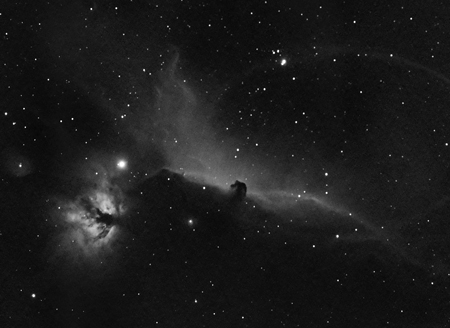
KerryLH
With Kerry’s permission I am posting her image after some colourization (TH):
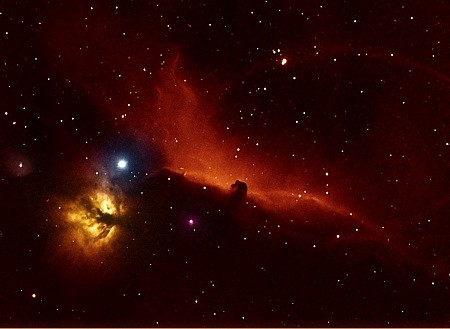
December’s Full Moon is called – Oak Moon, Cold Moon, Frost Moon, Long Night’s Moon, Moon Before Yule, or by its Hindustani name: Margashirsha Purnima.
This week, the full moon is at perigee – the closest point to Earth of its orbit – and the closest it has been all year making it the biggest full moon of 2008.
So, if you’re going to be out tonight – don’t forget your moonscreen 😉
Glenn
It’s currently clear skies in Burlington as I write this. I just checked and noticed that there will be a grazing occultation early Thurs morning at about 3am. I got the info from Brad Timerson’s website:
http://www.timerson.net/IOTA/
The moon will be skimming ZC537, a mag 3.7 star, elevation 33deg, azimuth 274deg (almost due west). It appears that it is in Taurus (aka 17 Tauri). The star will pass along the southern limb of the moon.
It’s a bright star and should be naked eye visible, so you won’t need much equipment. The moon is nearly full, but you may get lucky a catch part of it near the dark portion. So maybe a filter (variable) might be helpful.
The center of the track will be just south (about 2km) of Binbrook CA, so it will be visible from our regular observing area.
Here are some of the details:
E. Longit. Latitude U.T. Sun Moon TanZ PA AA CA o ' " o ' " h m s Alt Alt Az o o o - 80 30 0 43 15 48 8 7 9 34 273 1.49 174.8 188.06 4.24S - 80 0 0 43 6 59 8 7 40 33 273 1.52 174.9 188.13 4.17S - 79 30 0 42 58 3 8 8 11 33 274 1.55 175.0 188.20 4.09S - 79 0 0 42 48 59 8 8 41 32 274 1.57 175.1 188.28 4.02S
If the conditions hold (CSC doesn’t report the current clearing, so who knows), and if you’re feeling brave enough, give it a try. I know I’ll be snug in my bed, but others may be more adventurous.
If you don’t like this one, the next one in our area will be on Dec 17 visible from the waterfront in Mississauga at about 6:20am. (ZC1705, a mag 7.6 star.
Good luck.
Update 21:50 – Hmmm, just checked Heavens Above http://www.heavens-above.com and it appears that there are 3 comets between mag 9.5 and 11.3 located in the area between Taurus and Ares and Triangulum. P/2008 Q2 Ory(mag 9.5), 144P Kushida(mag 11.1), and P/2008 QP20 Linear-Hill(mag 11.3).
Well, the internet is full of pictures of the beautiful grouping of the Moon, Jupiter and Venus that occured earlier tonight. Sadly, we experienced some pretty bad weather here, and I certainly didn’t see a thing. If any of you did, I hope you will post a comment on the blog and share your experiences with us.
A couple of nights ago, though, Jackie, Don and I went out to Binbrook and enjoyed a prelude to the Big Event. Venus and Jupiter were only a few degrees apart and made a beautiful pairing in the western sky. Clouds and cold temperatures did their best to thwart us, be we succeeded in seeing not just the conjunction but many other lovely views of the fall sky.
This all too brief observing session was followed up by some hot food and drink, and we were all delighted when Cathy joined us for some good conversation. It was overcast by the time we all headed home, but it will clear again, perhaps soon…perhaps soon…
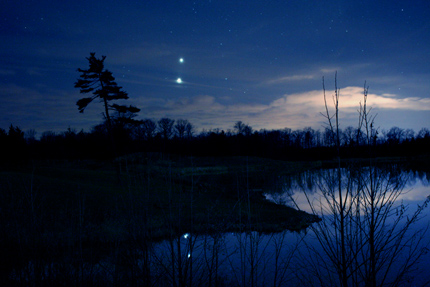
I was all ready with camera in hand (well, on a tripod) and looking forward to a well placed pass of the International Space Station and the shuttle Endeavor over Hamilton this evening. Naturally, just before they were due to arrive, clouds rolled in. Of course, this big piece of space hardware is so bright that it showed easily through the thin cloud and light pollution. Here is a shot of it going behind the clouds and in front of Cassiopeia.
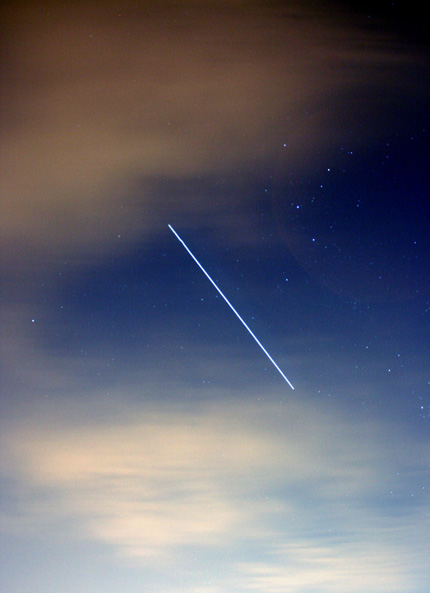
There are more passes visible this week, so be sure to take advantage of this opportunity to see the ISS and space shuttle, and don’t forget to wave at the astronauts on board as they go by!
These handbooks contain a wealth of data about the coming year’s celestial events,
and many chapters about astronomical topics.
I am buying one…
Since there are already 11 members requesting a copy,
I will be able to pass the quantity discounts to any who
email me in the next week or so to reserve a copy, for payment and
pick-up at our Dec 12 meeting, or otherwise, by special arrangement.
Please email me at chair@amateurastronomy.org
Update:
We are up to 14 orders now. They will be purchased early next week.
Speak now or be prepared to pay more later.
Steve Germann
My own web site of astrophotos and comet images has been updated with some of my most recent images (including the Jupiter and Milky Way image below).
My digital images page is:
http://home.interlynx.net/~bxmas/rpcDigitalImages.htm
My page of comet images is:
http://home.interlynx.net/~bxmas/rpcComet.htm
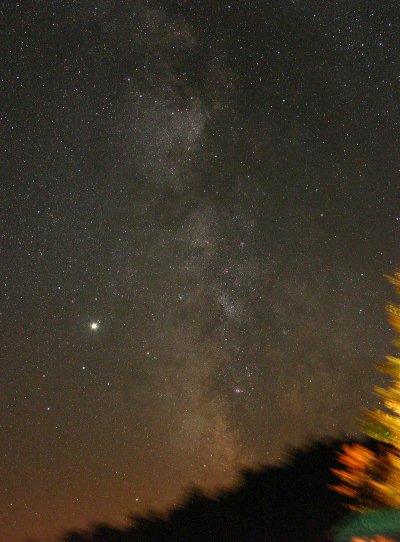
Bob C.
For the past couple of years, Gail and I have spent an evening showing the grade six class of Grimsby?s Park Road Public School the showpieces of the night sky.
Last Wednesday (Nov. 5th) would be our third outing and proved to have the best turnout yet as the teacher had invited another school?s grade six class to join us.
We couldn?t have asked for better conditions and Gail soon had a line up, at our 6? dob, to look at the Moon and Jupiter while I entertained another group with views of M31/32, the Ring Nebula, and Albireo as captured by our 12? reflector.
One of the parents also set up a Meade ETX so the 35 kids and 20 adults had a variety of scopes to look through. A few had brought binoculars so my laser pointer got some use as I showed them where to find the Pleiades, Andromeda Galaxy, and Brocchi?s Cluster (The Coathanger).
About 8pm, everyone was ushered into one of the portable classrooms where I gave a short presentation designed to answer some of their most pressing questions such as how many stars are there?; what is a black hole?; what is a worm hole?; and do galaxies ever collide?
For that last one I?d downloaded a small animation program called Colliding Galaxies which I think went over really well as the kids kept asking me to ?do another one!?.
We all had an excellent time, and one or two of the adults expressed some interest in the HAA so perhaps we?ll see them at a future meeting.
If you?d like to download the galaxy crashing program for yourself, you can get a free demo version at:
http://www.colliding-galaxies.com/Site/e-down.html
Glenn